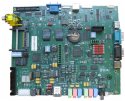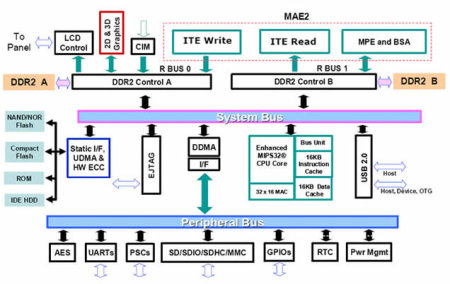MIPS32 SoCs decode HD, run Linux
Jan 16, 2009 — by Eric Brown — from the LinuxDevices Archive — 135 views Raza (RMI) announced a line of MIPS32-based SoCs for portable and low-powered multimedia devices. Sampling with a development board and Linux or Windows CE BSPs, the Au1300 SoCs will clock to 1GHz, and use half a Watt to decode 720p video, the company says.
Raza (RMI) announced a line of MIPS32-based SoCs for portable and low-powered multimedia devices. Sampling with a development board and Linux or Windows CE BSPs, the Au1300 SoCs will clock to 1GHz, and use half a Watt to decode 720p video, the company says.
(Click for larger view of the DBAu1300 development board for the Au1300)
The Alchemy Au1300 targets portable devices, including mobile Internet devices (MIDs), digital photo frames (DPFs), 3D personal navigation devices (PNDs), portable media players (PMPs), audio/video networking devices, and thin clients, says RMI.
As with RMI's other Alchemy processors, the Au1300 is based on a MIPS32 core. RMI says that future Au13xx SoCs should be able to scale to 1GHz, although the fastest models announced today top out at 800MHz. Specific models and their highlighted features include:
 |
Au1380 | Au1370 | Au1350 | Au1340 |
|---|---|---|---|---|
| Max Clock | 800MHz | 800MHz | 667MHz | 667MHz |
| Max video decode res. | 720p (1280×720) | 720p (1280×720) | D1 (720×480) | D1 (720×480) |
| Graphics | 2D/3D Acceleration | 2D | 2D/3D Acceleration | 2D |
| AES | Yes | No | Yes | No |
RMI Alchemy Au1300-series chip models
The 3D graphics models (1380 and 1350) offer a Graphics Processing Engine (GPE) based on ARM'S Mali family of Graphics Processing Units (GPUs). The GPE offers much-improved 3D graphics acceleration over the older Au1250, says RMI. Linux 2.6 drivers are provided for the Mali GPE, along with a full Linux board support package (BSP) for the Au1300 SoCs (see farther below).

Au1300 block diagram
(Click to enlarge)
All of the Au1300 SoCs are equipped with an Media Acceleration Engine (MAE2) that performs bit stream acceleration and entropy decode processes that, in the Au1250, were handled by the CPU core, says RMI. Offloading these functions enables 720p HD video decoding at higher bit rates, while freeing up CPU headroom for multitasking, claims the company. By incorporating dual independent DDR2 controllers, among other enhancements, system bus bandwidth for both internal and external bussing has been increased, with a 4x improvement in system bus utilization, claims RMI.
The following specifications are listed for the Au1300 processors, with differences noted between the four individual SoCs:
- Core — MIPS32 core at 800MHz (Au1380 and Au1370) or 667MHz (Au1350 and Au1340) with 1.0V nominal core voltage
- Caches — 16KB non-blocking data cache; 16KB instruction cache
- MMU — 32 dual-entry fully-associative TLB
- Memory buses:
- High-bandwidth dual DDR2 SDRAM memory controller (supports up to DDR2-667)
- Support for up to 8 banks
- SRAM controller with IDE and NOR/NAND flash support (and with large/small block, SLC/MLC NAND)
- CompactFlash support
- External 10/100 Ethernet controller support
- Storage interface — UltraDMA (UDMA) with high-performance transfer to IDE; ATA-6/UDMA mode 5 compliant
- Media Acceleration Engine (MAE2) — hardware acceleration for MPEG1, 2, 4, DivX, H.264, VC-1, JPEG; up to 720p (1280×720) video decode; WUXGA (1920×1200) LCD; hardware color-space conversion and scaling
- Graphics Processing Engine — ARM Mali accelerator (Au1380 and Au1350 only):
- Open GL ES 1.1 and 2.0 and OpenVG 1.1
- Vertex and fragment shaders
- 10M polygons per second
- 4x full-screen anti-aliasing
- Up to 25x FSAA supported
- Alpha blending and texture caching
- Peripheral support:
- 2 x USB 2.0 device and host controllers with OTG support
- 75 total GPIOs
- 4 x UARTs
- 4 x programmable serial controllers (PSC), each supporting AC97, I2S, SPI, and SMBus protocols
- 3 x Secure Digital/SDHC/SDIO/MMC controllers (one with 8-bit eMMC 4.3)
- Camera interface supporting 8 to 10-bit image sensors
- LCD controller with 32-bit alpha-RGB color resolution
- Security — AES-128 encryption/decryption in hardware (Au1380 and Au1350 only)
- Power — 1/2 Watt typical draw at 800MHz, with idle, sleep, and hibernate power-saving modes
- Packaging — 0.65mm and 0.8mm ball pitch BGA
- Other features — Extended temperature range options
- Operating system — Linux 2.6 and Windows CE 6.0 supported by core BSPs and media SDKs
DBAu1300 development board and Linux BSP
RMI also announced a Linux-ready DBAu1300 development board (pictured at top). The board is equipped with an Au1380 SoC with 256MB DDR2 RAM, expandable to 1GB, plus 64MB total NOR flash (dual 256Mbit MirrorBit), 128MB to 256MB NAND flash, and memory card expansion. The DBAu1300 offers a 7-inch LCD touchscreen, as well as dual USB ports, a Mini-USB connector, and a 10/100 Ethernet MAC/PHY, plus UARTs and other I/O.
The development board comes with a variety of audio/video I/O, including HDMI output, audio codecs, and a 1.3-megapixel camera interface module. Programmable serial controllers are provided, along with cables, batteries, and a +12V DC external supply. An EJTAG header supports monitoring and debugging operations, says the company.
The DBAu1300 board ships with Linux 2.6 and Windows CE 6.0 board support packages (BSPs) and media software development kits (SDKs) that include drivers for the 2D/3D GPE, says RMI. A “Quick Start Guide” is also available, and demo images and media codecs can be downloaded from the RMI developers support site.
Stated said Mike Wodopian, VP/GM, RMI, “With the inclusion of rich 3D acceleration for advanced user interfaces and 3D navigation, High Definition video decode, performance levels to 800 MHz and lower overall system power, the Au1300 Family will allow us to serve a broader customer base in the consumer media and enterprise markets.”
Stated Lance Howarth, VP and GM, Media Processing Division, ARM, “Our work with RMI has resulted in an outstanding proof point for the power and efficiency of ARM Mali 3D graphics solutions.”
Availability
RMI did not provide pricing or availability information on the Alchemy Au1300 SoCs or the DBAu1300 development board. More information may be found here
This article was originally published on LinuxDevices.com and has been donated to the open source community by QuinStreet Inc. Please visit LinuxToday.com for up-to-date news and articles about Linux and open source.